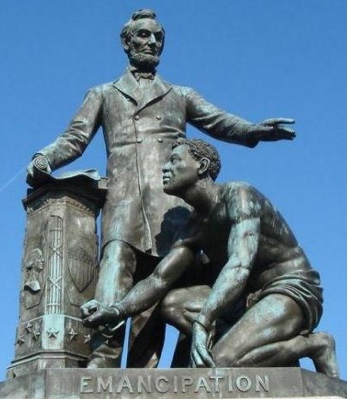Even “Good Statues” Have Their Problems

Statue at the Emancipation Memorial in Washington DC.
Archer Alexander was an enslaved African who fought for freedom from bondage during the American Civil War. His story recently came to light when a 23andMe genetic test showed that Alexander was an ancestor of Muhammad Ali. He was Ali’s great-great-great grandfather, although Ali did not know of the relationship and probably did not know Alexander’s story.
Alexander’s biography was written and published in 1885 and is available on North Carolina University’s Documenting the American South website. It was written by William Greenleaf Eliot, a minister, abolitionist, and founder and president of Washington University in St. Louis, Missouri.
Archer Alexander was born near Richmond, Virginia, probably in 1813. His father was sold while he was a young boy. When he was eighteen his “master” died and Alexander was inherited by his master’s son, who separated him from the rest of his family and brought him to Missouri. In Missouri Alexander was allowed to marry and was sold to the wife of his wife’s “master.”
While Missouri did not secede from the Union during the Civil War, many Missourians were Confederate sympathizers, including Alexander’s owner. In 1863, Alexander began passing information about Confederate military activities including plans to destroy a train trestle and the location of hidden weapons stashes to United States forces.
Suspected of being a Union agent, Alexander fled to St. Louis evading slave catchers. While there he worked in the home of William Greenleaf Eliot, who became his biographer, and helped his wife and a daughter to join him in freedom.
According to Eliot, Alexander was the person used as the model for the “Freedman’s Memorial” statue in Washington DC. But Alexander was not “freed” by Abraham Lincoln. The Emancipation Proclamation, issued in January 1863 was limited in scope to rebel territory. Since Missouri had not seceded from the union, the 114,931 enslaved Africans listed in the1860 federal census for Missouri were not freed by Abraham Lincoln.
Archer Alexander was a self-emancipator. Instead of being depicted on his knees at Lincoln’s feet, Archer Alexander should be shown standing tall, a free man and a Civil War hero who risked his life defending the Union and fighting for an end to slavery.
WhenMuhammad Ali changed his name from Cassius Clay in 1964, he explained, “Why should I keep my white slavemaster’s name visible and my black ancestors invisible, unknown, unhonored?”
Ali was definitely right. It is way past time for the United States, not only to take down statues that honor Confederate traitors and racists, but to rethink how we tell the story of the United States.
The wave of protests against statue’s honoring Confederates has definitely provoked new interest in the importance of studying the American past for understanding the present and preparing for the future.
At Hofstra University, where I teach history and social studies education, during the Spring 2018 semester students raised serious questions about a statute outside the student center that honors Thomas Jefferson as author of the Declaration of Independence. Protests centered on whether Jefferson’s role as a slaveholder, as a participant in the domestic slave trade, and his sexual relationship with a teenaged Sally Hemings (who he owned as a slave) outweigh the positive contributions he made to the nation. Protesters wanted the statue removed.
After meetings with university officials, Hofstra established a Presidential Task Force on Representation in Public Spaces to report on both existing statues and possible new statues and plaques. Hofstra is also planning an academic conference for Fall 2019 examining the impact of the trans-Atlantic slave trade on the creation of the modern world and on race relations in the United States. For now the Thomas Jefferson statue will remain, but whatever the final resolution, the statue debate has definitely precipitated a much broader awareness of history on campus.
According to a recent national survey by the Woodrow Wilson National Fellowship Foundation, only a third of Americans would pass if they had to take the test to become a United States citizen. Let’s hope the statue debate and renewed attention to history will raise test scores.